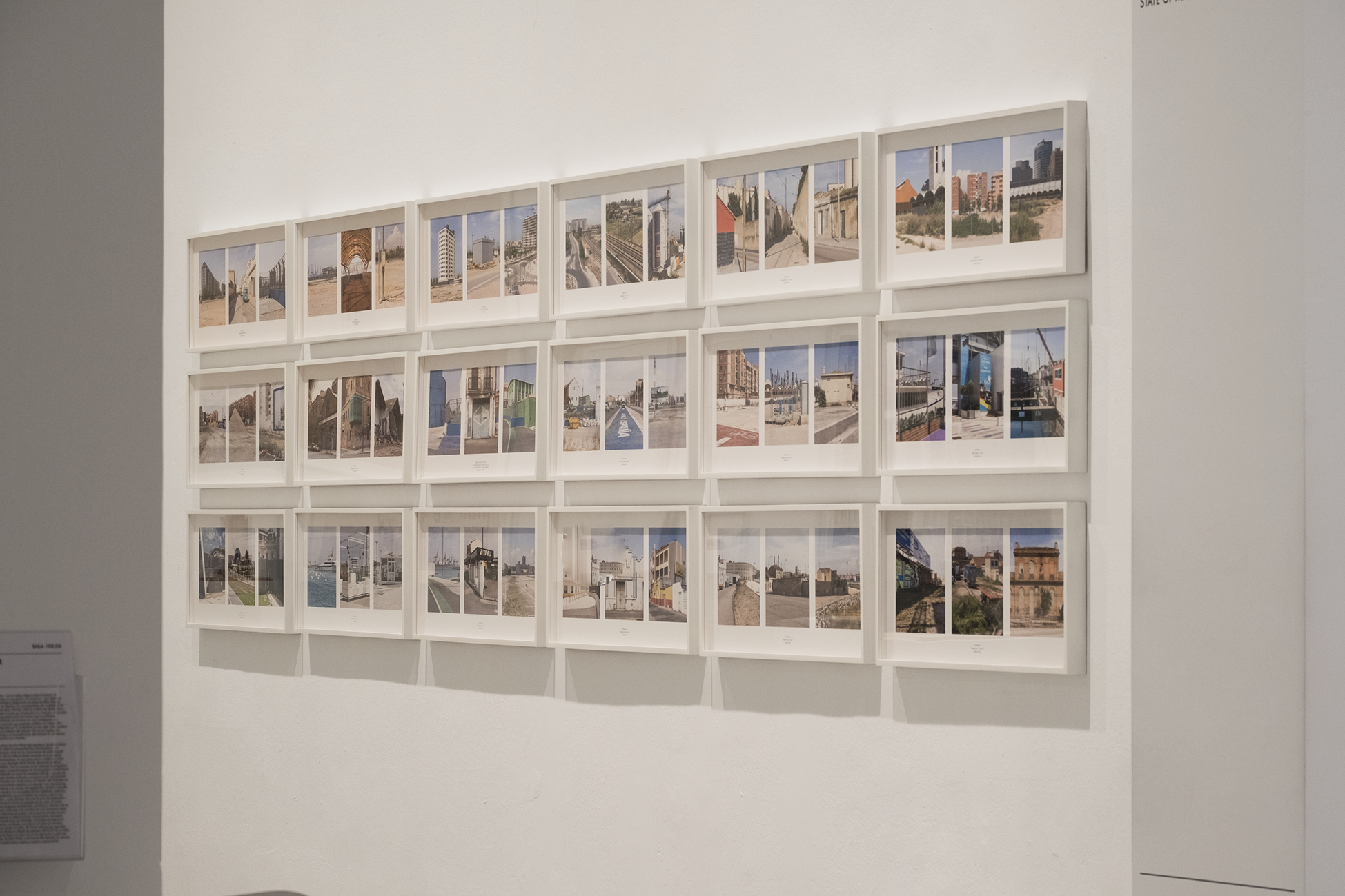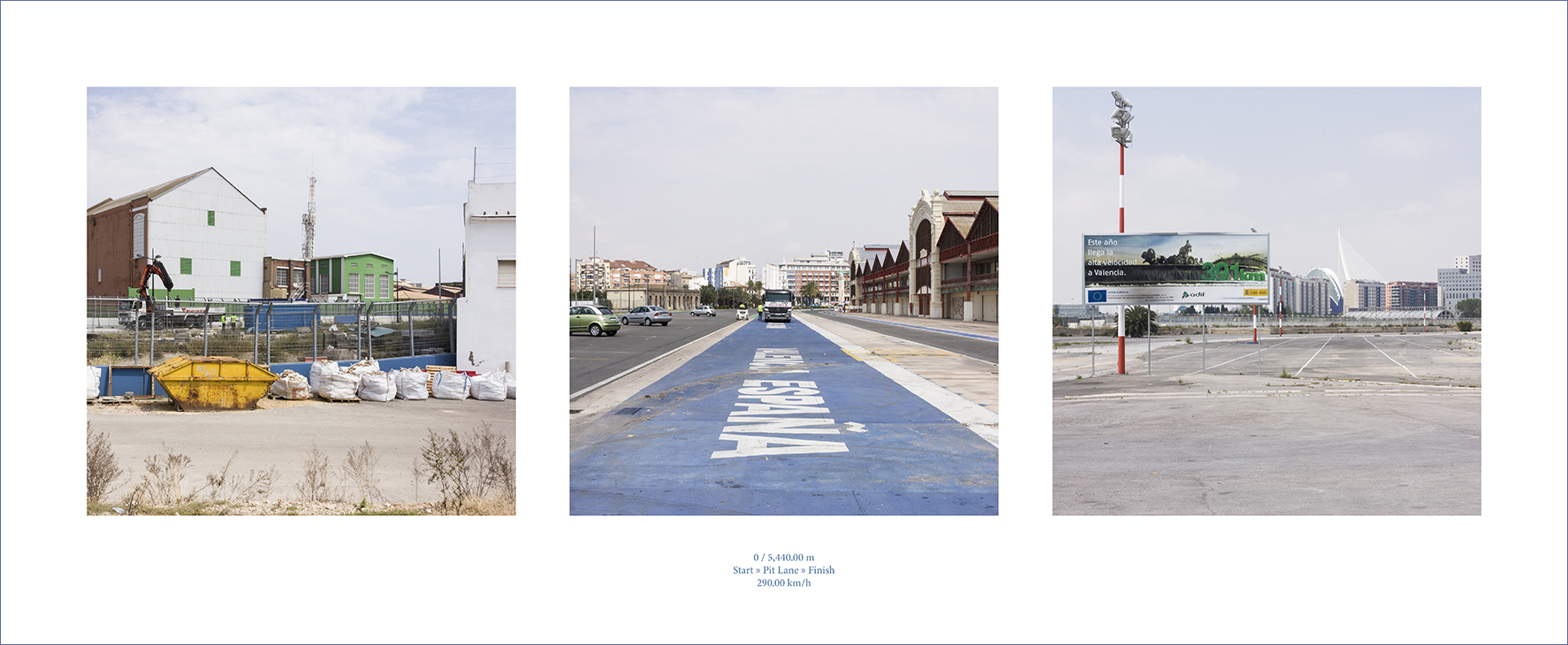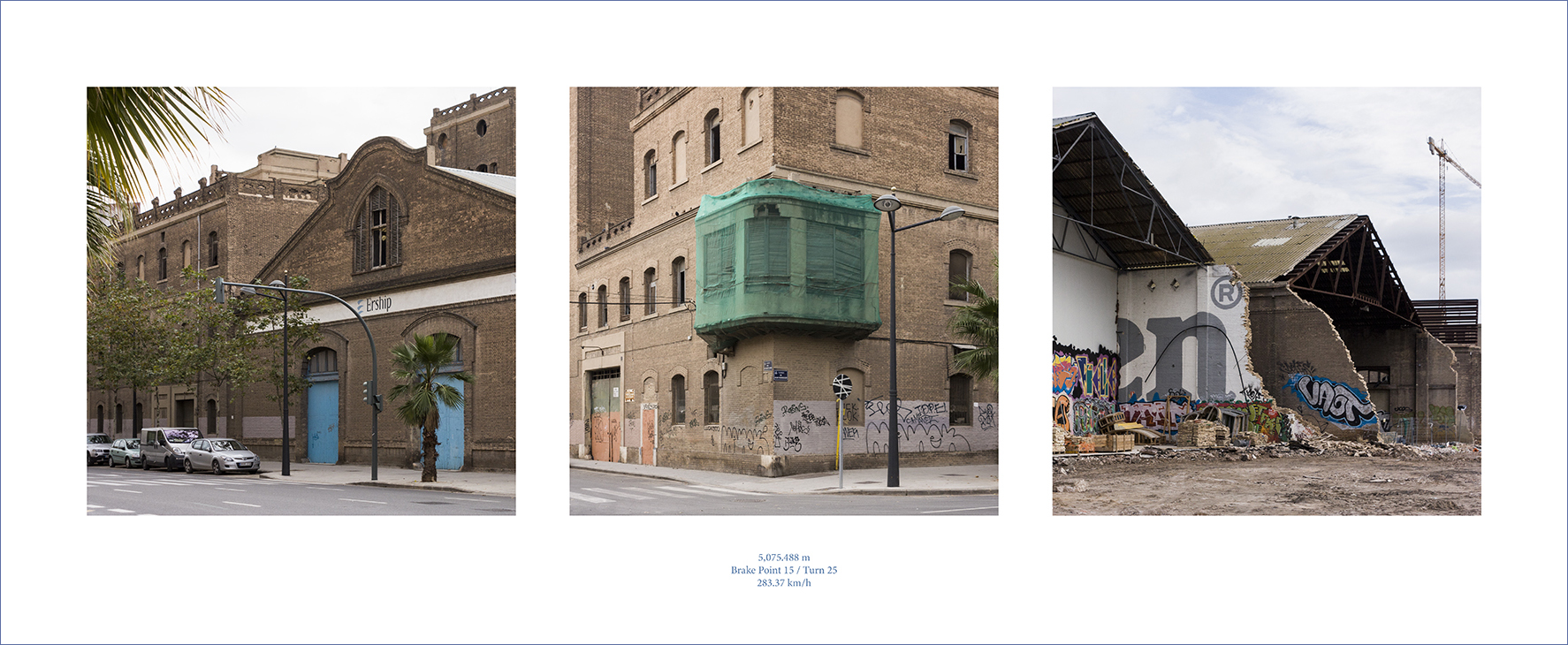



















La primera edición del Gran Premio de Europa en el circuito urbano de Formula 1 de Valencia se celebró en 2008. Para entonces, ya se habían inaugurado varios macro-proyectos en la zona. De las muchas intervenciones que el Gobierno de la Comunidad Autónoma y el Ayuntamiento (en manos de Francisco Camps y Rita Barberá respectivamente) promovieron en el área, tal vez la más conocida era La Ciudad de las Artes y las Ciencias, un conjunto de edificios de gran envergadura sin una función claramente definida cuya construcción lideró el arquitecto Santiago Calatrava. En 2007, sobre la dársena histórica del puerto y para albergar la America’s Cup de vela, se construyó la Marina Real Juan Carlos I. Aunque la regata solo se celebró en dos ocasiones (2007 y 2010), la remodelación del puerto contó con la participación del arquitecto británico David Chipperfield. En 2012, con la mayoría de sus edificios fuera de uso, la deuda acumulada por este complejo alcanzaría los 500 millones de euros. También en 2012, tras cinco años de obras, finalizó la primera fase de la ampliación de la ZAL, una de las zonas portuarias de actividades logísticas más grandes de Europa.
El circuito de Formula 1 fue un proyecto coherente con la línea de actuaciones desenfrenadas que las instituciones valencianas habían llevado a cabo hasta la fecha. Según se insistía, el proyecto actuaría como generador de empleo y fuente de riqueza. Un “Mónaco español” que serviría también como detonante para la construcción de un nuevo ensanche urbano destinado a aumentar la densidad de población en la zona, hasta el momento llamativamente baja. Sin embargo, el estallido de la burbuja inmobiliaria y el desplome del sistema financiero, hicieron inviable la continuidad del proyecto. En 2012, tras la victoria para Ferrari de Fernando Alonso en la quinta edición del campeonato, el circuito quedó clausurado para siempre. Se estima que en aquel momento, la inversión pública destinada al evento alcanzaba los 295 millones de euros. La Generalitat Valenciana dedicó 98 millones de euros a la construcción de la infraestructura y las dotaciones necesarias para la realización del evento. En 2009, tras rescatar a la promotora encargada de la organización, Valmor Sport SL, las arcas públicas asumieron una deuda acumulada de 147 millones de euros (117 en concepto de canon por cinco temporadas para Formula One Group y 40 millones adicionales en otras deudas acumulados por la empresa). Finalmente, aunque el campeonato era ya televisado por una cadena privada a escala nacional, la televisión pública valenciana invirtió un total de 40 millones de euros en derechos no exclusivos de retransmisión. Estos proyectos, según afirmaban sus promotores, estaban destinados a “situar en el mapa” a la capital del Turia. Si así lo hicieron, fue a costa de un severo impacto ambiental, urbano y económico y en contra de los múltiples movimientos ciudadanos que se opusieron a su desarrollo.
En los márgenes se elaboran las historias que no nos cuentan, aquellas que por su crudeza y vivacidad quedan relegadas del marco escenográfico que limita nuestra mirada. El recorrido del trazado original nos guía desde la zona de salida. La narración a través de las fotografías de vestigios y de todo aquello que siempre ha estado ahí, materializa lo que podríamos denominar el fin de fiesta.
La utopía convertida en realidad. Una mise-en-scène dispuesta por interés político para disfrutar del espectáculo, ya que nada parecía comprometer un futuro atado y bien atado. El presente se manifiesta a través de la fotografía documental como medio para elaborar un nuevo relato. Desde un extremo nos enfrentamos a una percepción cada vez más compleja de la realidad. La historia particular sobre lo que ‘ha sido’, añade una perspectiva crítica y reivindicativa, que por otro lado sustenta la reflexión sobre el carácter escénico de las propias prácticas políticas.
La relación de la fotografía con lo artístico se materializa en lo teatral. Las tomas fotográficas se limitan a un marco estrecho, tras el cual se presiente que la acción no tiene continuidad. Situarse en los márgenes, trata de satisfacer la exigencia de salirse del marco fotográfico y mirar más allá, hacia el campo ciego donde la ilusión teatral desaparece, para dejar paso a los restos y a todo aquello que se ocultó. Esta percepción de la realidad a través de las imágenes conforma nuevos imaginarios para el espectador y nuevas formas de producción e interpretación del sentido.
A través de los márgenes hemos seguido un recorrido alternativo. Como si fuesen anotaciones, las fotografías reflejan la farsa, el abandono, el vacío… que junto a los restos de todo aquello que ha sido excluido, delimitan nuestra posición.
Texto de Adrián Prieto (2013)
El circuito de Formula 1 fue un proyecto coherente con la línea de actuaciones desenfrenadas que las instituciones valencianas habían llevado a cabo hasta la fecha. Según se insistía, el proyecto actuaría como generador de empleo y fuente de riqueza. Un “Mónaco español” que serviría también como detonante para la construcción de un nuevo ensanche urbano destinado a aumentar la densidad de población en la zona, hasta el momento llamativamente baja. Sin embargo, el estallido de la burbuja inmobiliaria y el desplome del sistema financiero, hicieron inviable la continuidad del proyecto. En 2012, tras la victoria para Ferrari de Fernando Alonso en la quinta edición del campeonato, el circuito quedó clausurado para siempre. Se estima que en aquel momento, la inversión pública destinada al evento alcanzaba los 295 millones de euros. La Generalitat Valenciana dedicó 98 millones de euros a la construcción de la infraestructura y las dotaciones necesarias para la realización del evento. En 2009, tras rescatar a la promotora encargada de la organización, Valmor Sport SL, las arcas públicas asumieron una deuda acumulada de 147 millones de euros (117 en concepto de canon por cinco temporadas para Formula One Group y 40 millones adicionales en otras deudas acumulados por la empresa). Finalmente, aunque el campeonato era ya televisado por una cadena privada a escala nacional, la televisión pública valenciana invirtió un total de 40 millones de euros en derechos no exclusivos de retransmisión. Estos proyectos, según afirmaban sus promotores, estaban destinados a “situar en el mapa” a la capital del Turia. Si así lo hicieron, fue a costa de un severo impacto ambiental, urbano y económico y en contra de los múltiples movimientos ciudadanos que se opusieron a su desarrollo.
En los márgenes se elaboran las historias que no nos cuentan, aquellas que por su crudeza y vivacidad quedan relegadas del marco escenográfico que limita nuestra mirada. El recorrido del trazado original nos guía desde la zona de salida. La narración a través de las fotografías de vestigios y de todo aquello que siempre ha estado ahí, materializa lo que podríamos denominar el fin de fiesta.
La utopía convertida en realidad. Una mise-en-scène dispuesta por interés político para disfrutar del espectáculo, ya que nada parecía comprometer un futuro atado y bien atado. El presente se manifiesta a través de la fotografía documental como medio para elaborar un nuevo relato. Desde un extremo nos enfrentamos a una percepción cada vez más compleja de la realidad. La historia particular sobre lo que ‘ha sido’, añade una perspectiva crítica y reivindicativa, que por otro lado sustenta la reflexión sobre el carácter escénico de las propias prácticas políticas.
La relación de la fotografía con lo artístico se materializa en lo teatral. Las tomas fotográficas se limitan a un marco estrecho, tras el cual se presiente que la acción no tiene continuidad. Situarse en los márgenes, trata de satisfacer la exigencia de salirse del marco fotográfico y mirar más allá, hacia el campo ciego donde la ilusión teatral desaparece, para dejar paso a los restos y a todo aquello que se ocultó. Esta percepción de la realidad a través de las imágenes conforma nuevos imaginarios para el espectador y nuevas formas de producción e interpretación del sentido.
A través de los márgenes hemos seguido un recorrido alternativo. Como si fuesen anotaciones, las fotografías reflejan la farsa, el abandono, el vacío… que junto a los restos de todo aquello que ha sido excluido, delimitan nuestra posición.
Texto de Adrián Prieto (2013)
Valencia Street Circuit, now inactive, is one of the most significant examples of the city's transformation in the years leading up to the financial crisis, the years of the speculative bubble. Neoliberal institutional policy galvanized a transformation towards an urban development model based on the touristic exploitation of the city. A model that turned its back on the citizens that now witness the collapse of their old social conquests. A disproportinate project both in the initial investment and final overcost. The development criteria concerning the planning and impact assessment on the city's economy were also extremely questionable. Today, Valencia's economic and social bankruptcy, aggravated by the institution's many corruption scandals, calls into question this model, that, nevertheless, remains the only viable growth alternative according to all levels of government.
Untold stories are written in the margins, those stories whose rawness and vivacity are cast aside from the scenographic frame that limits our gaze. The route of the original track guides us from the start line. The narration through the photographs of remains and through everything that was already there materializes what we could call the closing ceremony.
The utopia turned into reality. A mise-en-scène arranged by political interest to enjoy the show, since nothing seemed to compromise a future all tied up. The present manifests itself through documentary photography as the means to elaborate a new recounting. From the far end we face an increasingly complex view of reality. The characteristic history of what “has been” adds a critical and vindicating perspective, that, on the other hand, backs up a consideration of the scenographic nature of political praxis.
Photography’s relationship with art materializes in the theatrical. The photographic takes are limited to a narrow frame, beyond which a lack of continuity in the action is felt. The act of positioning oneself in the margins aims to satisfy the demand to escape the photographic frame and look beyond, towards the blind field where theatrical illusion vanishes, to give way to the remains and everything that was hidden. This perception of reality through the images shapes a new imagery for the viewer and new forms of production and interpretation of meaning.
Through the margins we have travelled an alternative course. As if they were notes, the pictures reflect the farce, the neglect, the void… that together with the remains of all that has been excluded, frame our position.
Text by Adrián Prieto (2013) / Translation by Marta Génova
Untold stories are written in the margins, those stories whose rawness and vivacity are cast aside from the scenographic frame that limits our gaze. The route of the original track guides us from the start line. The narration through the photographs of remains and through everything that was already there materializes what we could call the closing ceremony.
The utopia turned into reality. A mise-en-scène arranged by political interest to enjoy the show, since nothing seemed to compromise a future all tied up. The present manifests itself through documentary photography as the means to elaborate a new recounting. From the far end we face an increasingly complex view of reality. The characteristic history of what “has been” adds a critical and vindicating perspective, that, on the other hand, backs up a consideration of the scenographic nature of political praxis.
Photography’s relationship with art materializes in the theatrical. The photographic takes are limited to a narrow frame, beyond which a lack of continuity in the action is felt. The act of positioning oneself in the margins aims to satisfy the demand to escape the photographic frame and look beyond, towards the blind field where theatrical illusion vanishes, to give way to the remains and everything that was hidden. This perception of reality through the images shapes a new imagery for the viewer and new forms of production and interpretation of meaning.
Through the margins we have travelled an alternative course. As if they were notes, the pictures reflect the farce, the neglect, the void… that together with the remains of all that has been excluded, frame our position.
Text by Adrián Prieto (2013) / Translation by Marta Génova
Valencia Street Circuit, now inactive, is one of the most significant examples of the city's transformation in the years leading up to the financial crisis, the years of the speculative bubble. Neoliberal institutional policy galvanized a transformation towards an urban development model based on the touristic exploitation of the city. A model that turned its back on the citizens that now witness the collapse of their old social conquests. A disproportinate project both in the initial investment and final overcost. The development criteria concerning the planning and impact assessment on the city's economy were also extremely questionable. Today, Valencia's economic and social bankruptcy, aggravated by the institution's many corruption scandals, calls into question this model, that, nevertheless, remains the only viable growth alternative according to all levels of government.
- - - - -
Untold stories are written in the margins, those stories whose rawness and vivacity are cast aside from the scenographic frame that limits our gaze. The route of the original track guides us from the start line. The narration through the photographs of remains and through everything that was already there materializes what we could call the closing ceremony.
The utopia turned into reality. A mise-en-scène arranged by political interest to enjoy the show, since nothing seemed to compromise a future all tied up. The present manifests itself through documentary photography as the means to elaborate a new recounting. From the far end we face an increasingly complex view of reality. The characteristic history of what “has been” adds a critical and vindicating perspective, that, on the other hand, backs up a consideration of the scenographic nature of political praxis.
Photography’s relationship with art materializes in the theatrical. The photographic takes are limited to a narrow frame, beyond which a lack of continuity in the action is felt. The act of positioning oneself in the margins aims to satisfy the demand to escape the photographic frame and look beyond, towards the blind field where theatrical illusion vanishes, to give way to the remains and everything that was hidden. This perception of reality through the images shapes a new imagery for the viewer and new forms of production and interpretation of meaning.
Through the margins we have travelled an alternative course. As if they were notes, the pictures reflect the farce, the neglect, the void… that together with the remains of all that has been excluded, frame our position.
Text by Adrián Prieto (2013) / Translation by Marta Génova[ENG]
Valencia Street Circuit, now inactive, is one of the most significant examples of the city's transformation in the years leading up to the financial crisis, the years of the speculative bubble. Neoliberal institutional policy galvanized a transformation towards an urban development model based on the touristic exploitation of the city. A model that turned its back on the citizens that now witness the collapse of their old social conquests. A disproportinate project both in the initial investment and final overcost. The development criteria concerning the planning and impact assessment on the city's economy were also extremely questionable. Today, Valencia's economic and social bankruptcy, aggravated by the institution's many corruption scandals, calls into question this model, that, nevertheless, remains the only viable growth alternative according to all levels of government.
- - - - -
Untold stories are written in the margins, those stories whose rawness and vivacity are cast aside from the scenographic frame that limits our gaze. The route of the original track guides us from the start line. The narration through the photographs of remains and through everything that was already there materializes what we could call the closing ceremony.
The utopia turned into reality. A mise-en-scène arranged by political interest to enjoy the show, since nothing seemed to compromise a future all tied up. The present manifests itself through documentary photography as the means to elaborate a new recounting. From the far end we face an increasingly complex view of reality. The characteristic history of what “has been” adds a critical and vindicating perspective, that, on the other hand, backs up a consideration of the scenographic nature of political praxis.
Photography’s relationship with art materializes in the theatrical. The photographic takes are limited to a narrow frame, beyond which a lack of continuity in the action is felt. The act of positioning oneself in the margins aims to satisfy the demand to escape the photographic frame and look beyond, towards the blind field where theatrical illusion vanishes, to give way to the remains and everything that was hidden. This perception of reality through the images shapes a new imagery for the viewer and new forms of production and interpretation of meaning.
Through the margins we have travelled an alternative course. As if they were notes, the pictures reflect the farce, the neglect, the void… that together with the remains of all that has been excluded, frame our position.
Text by Adrián Prieto (2013) / Translation by Marta Génova